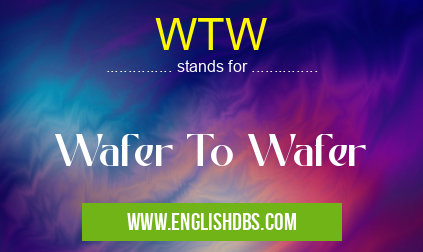What does WTW mean in UNCLASSIFIED
WTW stands for Wafer To Wafer. It is a packaging technology used in the fabrication of electronic devices, particularly in the assembly of semiconductor chips.

WTW meaning in Unclassified in Miscellaneous
WTW mostly used in an acronym Unclassified in Category Miscellaneous that means Wafer To Wafer
Shorthand: WTW,
Full Form: Wafer To Wafer
For more information of "Wafer To Wafer", see the section below.
WTW Process
WTW technology involves bonding multiple semiconductor wafers together to form a single, complex device. This is achieved through a series of steps:
- Wafer Preparation: The wafers are cleaned and patterned with the desired circuit designs.
- Bonding: The wafers are aligned and bonded together using various bonding techniques, such as eutectic bonding, thermocompression bonding, or anodic bonding.
- Interconnect Formation: Electrical connections are formed between the wafers using techniques such as through-wafer vias or wire bonding.
- Encapsulation: The bonded wafers are protected and encapsulated using materials such as polymer or ceramic.
Advantages of WTW
- Reduced Size and Footprint: WTW allows for the integration of multiple chips into a single, compact device, reducing the overall size and footprint.
- Improved Performance: WTW technology offers benefits such as lower power consumption, higher bandwidth, and reduced latency by eliminating the need for external interconnects.
- Cost Reduction: By integrating multiple chips into a single package, WTW can reduce manufacturing and assembly costs compared to traditional packaging methods.
- Increased Reliability: WTW bonding provides robust electrical and mechanical connections, enhancing the reliability of the device.
Applications of WTW
WTW technology is widely used in various electronic applications, including:
- High-Performance Computing (HPC): WTW facilitates the integration of multiple processor chips into a single package, enabling high-performance computing systems.
- Artificial Intelligence (AI): WTW enables the integration of AI accelerators and memory chips into a compact device, supporting demanding AI applications.
- Mobile Devices: WTW technology is used in mobile devices to enhance performance and reduce size, particularly in applications such as image processing and multimedia.
- Optical Communications: WTW is employed in optical communications systems to integrate laser diodes and detectors into a single package.
Essential Questions and Answers on Wafer To Wafer in "MISCELLANEOUS»UNFILED"
What is Wafer To Wafer (WTW) Bonding?
Wafer To Wafer (WTW) Bonding is a semiconductor fabrication technique used to bond multiple semiconductor wafers together, creating a 3D structure. It involves aligning and bonding two or more wafers, often using a thin adhesive layer, to form a multi-layer semiconductor device.
What are the Applications of WTW Bonding?
WTW Bonding enables the creation of complex 3D integrated circuits (ICs) with enhanced performance and functionality. It is used in various applications, including:
- Stacking of memory chips to increase memory density
- Integration of different types of chips, such as logic and memory, to create heterogeneous systems-on-chip (SoCs)
- Fabrication of 3D sensors and actuators for advanced electronics and biomedical devices
What are the Advantages of WTW Bonding?
WTW Bonding offers several advantages, such as:
- Increased device density and functionality by stacking wafers
- Improved performance due to reduced interconnect lengths and crosstalk
- Enhanced thermal management by using multiple layers for heat dissipation
- Reduced manufacturing costs compared to traditional 2D integration methods
What are the Challenges in WTW Bonding?
WTW Bonding presents some challenges, including:
- Precise alignment and bonding of wafers to ensure electrical connectivity
- Avoidance of defects and contamination at the bonding interface
- Management of thermal stresses and warpage due to the stacked structure
- Development of reliable and efficient bonding materials and processes
What is the Future of WTW Bonding?
WTW Bonding is a rapidly evolving technology with significant potential for advancements. Ongoing research focuses on:
- Improving bonding techniques for higher precision and reliability
- Development of new materials for enhanced bonding strength and thermal properties
- Exploration of novel 3D device architectures and applications
Final Words: WTW is a critical technology in the fabrication of electronic devices, offering advantages in size reduction, performance enhancement, cost optimization, and reliability. Its versatility and applications across various industries make it an essential component in the development of advanced electronic systems.
WTW also stands for: |
|
| All stands for WTW |
